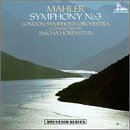| All Artists: Gustav Mahler, Jascha Horenstein, John McCarthy, Russell Burgess, Ambrosian Singers, Denis Wick, Norma Procter Title: Mahler: Symphony No. 3 In D Minor - Horenstein Members Wishing: 1 Total Copies: 0 Label: Unicorn Release Date: 12/6/1993 Album Type: Import, Box set Genre: Classical Style: Symphonies Number of Discs: 2 SwapaCD Credits: 2 UPCs: 053068200622, 5016908200621 |
Search - Gustav Mahler, Jascha Horenstein, John McCarthy :: Mahler: Symphony No. 3 In D Minor - Horenstein
 | Gustav Mahler, Jascha Horenstein, John McCarthy Mahler: Symphony No. 3 In D Minor - Horenstein Genre: Classical
|
Larger Image |
CD Details |
CD ReviewsHorenstein Captures the Essence of Mahler's Third Symphony Michael A Pahre | Cambridge, MA | 02/25/2000 (5 out of 5 stars) "Most lovers of Mahler---be they devoted or fleeting---find his Symphonies No 1, 4, or 5 to be the most accessible. The Symphony No 8 is rarely heard because of the large number of performers required, while the 2nd is heard fairly often despite nearly similar requirements. Lost among this list is the 'Great' Symphony No 3: a vast sea of music and emotion that is rarely tackled in the present day probably due to its sheer length (more than 100 minutes in most performances).The 3rd symphony is a unique piece of classical music in that virtually every human emotion can be found among its six movements and many pages. While Mahler later discounted his programmatic descriptions of the movements, they genuinely provide insight into this work. The first movement, as long as anything Bruckner ever wrote, describes the awakening of the world and begins with a glorious horn soli that can be found nowhere else than in Tchaikovsky's 4th Symphony. The work passes by the animals and flowers, finally arriving in the wisdom of children and love in the 5th and 6th movements, respectively. The finale ends with one of the most beautiful yet dramatic passages in all of late German Romanticism.Jascha Horenstein is not a marquee name conductor, but this one recording from the early 1970s vaulted him to exalted status among aficionados of the Mahler symphonies. He draws a top-notch performance from an orchestra which is not among the world's best. The horn section plays with remarkable sound and intonation, the trombone, posthorn, and violin solos are all among the best to be found in any recording, and the pace of the entire work is careful laid out to the listener. I first purchased the LP two decades ago, and it has remained among my most treasured recordings. While Bernstein's recording with the New York Philharmonic in the 1960s is thought by many to be the most exciting or definitive, or the recording by Levine with the Chicago Symphony as having the greatest overall sound, the Horenstein recording attains the best overall performances and unity of expression." The Third Symphony with a true sense of awe. ScopeGuru | Chicago | 12/31/1999 (5 out of 5 stars) "Bruno Walter visited Mahler during the summer of 1896, and was at one point awestruck by the majestic beauty of the mountains surrounding Steinbach-am-Attersee. During that contemplative moment alone with his student, Mahler uttered his famous quote: "No need looking up there - That has all been composed by me!" The symphony he referred to was, of course, the Third. The fact that this is an all-encompassing symphony does not automatically dictates its grandeur in every performance. Many performances lose sight in the demanding details on which the music is built, and from which the music extracts its Herculean scope. No recorded performance distills the essence of the music to such humbling grandness as Horenstein's. The drama of nature, significant or mundane, is meticulously documented by Mahler in this symphony, and presented with almost imperceptible interference by the performers. The LSO musicians is in their top form and the Posthorn solo is the best I have heard, live or recorded. Horenstein handles every musical suspense masterfully, and the musical climaxes erupt with raw power matched only by the force of nature. The recording is marred by less than ideal sound (some of the more opulent orchestral details are lost) but it's still good quality considering the year it was recorded. This flaw should be completely overlooked judging from the value of the interpretation. This is an absolutely insightful and important rendition for anyone interested in studying the Third. In every playful tune and in every heart-breaking despair, in the most earth-shattering blasts and in the softest whispers, it takes Horenstein and the LSO to show that the Third Symphony is not only structurally grand, but also spiritually profound." THE Mahler Third Paul Bubny | Maplewood, NJ United States | 12/04/2002 (5 out of 5 stars) "Is this recording overpraised, overhyped, overrated by ardent Mahlerites? I don't think it is--as long as you don't expect to be clunked over the head by it. Instead of flooring you, this difficult-to-find 1970 classic wins you over by degrees, until you come to understand that this is the way Mahler's glorious, 97-minute hymn to Nature and God is supposed to go. A couple of potentially significant blemishes--some less-than-precise orchestral playing and a less-than-stellar recording job--pale into insignificance here. Nobody else has gotten it quite as "right" as Horenstein, although that still leaves room for some artistically successful also-rans, any one of which could be the top recommendation if it weren't for this. By the way, there IS another way of acquiring this recording besides hunting high and low and paying through the nose: a very inexpensive boxed set on Brilliant Classics (it may even be available thru [Amazon.com]) that not only costs less than the "collector's prices" you might have to pay, but gives you the other eight symphonies (not conducted by Horenstein, sad to say) in the bargain!"
|

 Track Listings (2) - Disc #1
Track Listings (2) - Disc #1